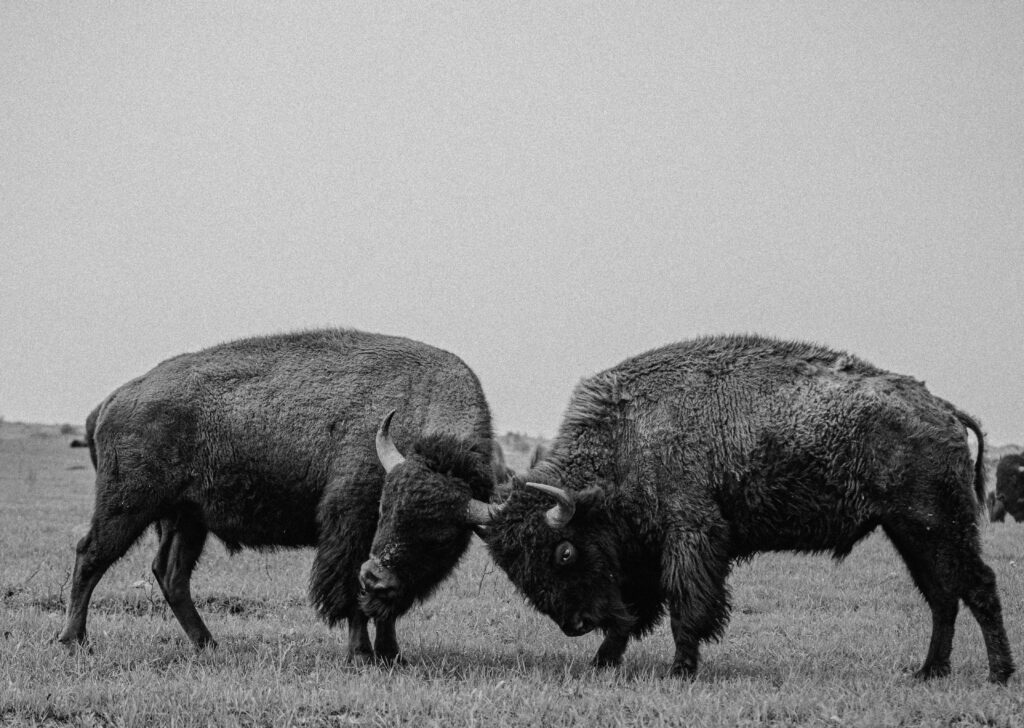Conor Kerr’s Prairie Edge opens in the late 1870s with a hunting party searching for a new buffalo herd: “They’ll come back. They always do. It might not be this year. It might not be in my lifetime. It might not be in your lifetime. But they’ll come back. These prairies were meant for the bison and we were meant to follow them, to work with them, to respect them. The bison are the land just as much as we are.” This passage encapsulates the premise of Kerr’s novel, a dark and gripping imagining of the “Land Back” movement in Alberta and Saskatchewan.
The buffalo do return to the prairies, though not via the expected means. Like Avenue of Champions, Kerr’s debut from 2021, Prairie Edge anticipates an era of Indigenous governance while also maintaining skepticism toward performative activism. Two Métis cousins, Isidore “Ezzy” Desjarlais and Grey Ginther, devise a plan to secretly relocate a bison herd from a national park to downtown Edmonton. The narrative fluidly alternates between their perspectives. Grey, once a passionate activist, has grown tired of dead-end corporatized crusading. She yearns to return to a world 150 years in the past. “We would have been in the carts going down into the Dakotas to hunt. You wouldn’t have had to go through all that foster care and group homes,” she tells Ezzy. “We wouldn’t even need any of that. Just us and the prairie and the buffalo.” For much of the novel, Kerr stays focused on this very trio: the cousins, the land, and the iconic animal.

Some 2,200 plains bison roam wild in Canada — but what if there were many, many more?
Ty Welch; Unsplash
Although the prologue begins in the nineteenth century, Kerr artfully transitions from thundering wagons on the undeveloped plains to a hot-wired truck rumbling through suburbia. Ezzy is at the wheel, a stubborn yet compelling protagonist, who envisions himself a “bison rustler” out of an “old-time western movie.” Reality, however, is no cinematic experience. Kerr depicts Ezzy’s struggles in the incarceration and foster care system with honesty, verve, and, on occasion, levity. “As badly as I didn’t want to go back to jail, letting Grey down would be worse,” he says. “If she dreamt bison, I’d make that happen. What else did I have going on?” Much of the book is punctuated with dreams of wildlife, particularly birds. Images of cranes, cedar waxwings, and magpies emphasize a craving to break free from the establishments that bind people.
Kerr builds romantic tension between his main characters only to humorously defuse it. While playing cribbage and drinking whisky one “cold, cold night,” Ezzy feels the urge to make out with Grey, only to get “too in my head thinking about the different ways this scenario could play out.” A few days later, she invites him to her apartment to show him something. “I really wanted to try to kiss her again. I thought that was why she was calling me over — we were going to hook up.” Instead, Grey greets Ezzy at the door by announcing, “I figured out how we’re cousins!” Mixed with banter and historical insight, the dialogue between the two flows naturally, making for a pleasurable reading experience. “You ever think about why magpies are such a nuisance?” Grey asks Ezzy at one point. “It’s because they’re sad that the bison went away. Their entire existence for millennia was built around being a part of the bison. Following them around, cleaning their fur, scavenging from the dung, they had this beautiful way of being with each other.”
Ezzy’s aunt, May, is among the book’s most vivid secondary characters. One can almost feel her pinching everyone’s cheeks, hear her chiding her loved ones, or taste her moose stew, which she pulls out of her seemingly bottomless deep freeze. When Ezzy is injured and lands up on May’s couch, he appreciates her propensity for storytelling. “I needed my auntie’s voice to soothe me,” he observes. “To tell me the stories I never had a chance to hear when I was a kid. When I’d needed them the most.” This sentiment is echoed in one of the Grey chapters, in which she describes her grandmother teaching her beadwork and gossiping: “It didn’t matter if she didn’t have all the facts or had to make some of it up herself. She loved to tell a good story.” Ezzy also learns beadwork, from a wise rehabilitation centre staff member named Joe. “My stitches look terrible,” Ezzy says, laughing. “What flower looks perfect in the world?” Joe asks him. “Each one has its own quirks and personality, you know.”
When the first group of buffalo is moved without a hitch, Grey sets her sights on relocating another: “Never underestimate the Métis. This is just us establishing a new herd.” The second time around, however, everything goes disastrously wrong. A bull crushes Ezzy’s leg in mid-heist, and the aftermath — for both him and Grey — changes life forever. While Ezzy is incarcerated for his involvement, Grey begins applying to graduate school — something he never thought she would do.
Near the end of Prairie Edge, Grey offers a sobering observation: “Ezzy had sacrificed himself to an activist dream. My activist dream. It was something that few people would ever think about actually doing. Myself included. Everyone was content to let dreams die when there were actual implications for their future.” Although Ezzy begins the book as a passive participant in his cousin’s schemes, Kerr ultimately establishes him as the narrative’s tragic hero. As Grey puts it, “Every successful revolution needs soldiers just as much as it needs poets and dreamers.”
Kayla Penteliuk studies and teaches literature at McGill University.

